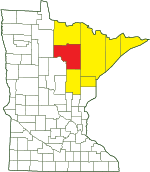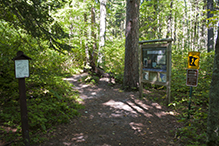Lost 40 SNA
About • Location • Activities • Ecology
About |
||
Ownership |
||
 |
||
|
||
Links |
||
Overview |
||
Lost 40 SNA lies within the borders of the Big Fork State Forest. It is in the Blackduck Area of the Chippewa National Forest. |
||
History |
||
|
||
Management |
||
|
||
Comments |
||
|
||
Location |
||||
Maps |
||||
Printable Map(s) with GPS coordinates |
||||
 |
||||
Size |
||||
114 acres |
||||
Parking |
||||
N47 45.970, W94 5.065 |
||||
Driving Directions |
 |
|||||
| Itasca County | ||||||
| Northeast Minnesota | ||||||
Activities |
||
Hiking Trails |
||
Lost 40 Trail: 1 mile |
||
Hunting |
||
All hunting. See Hunting and Trapping Regulations (MN DNR) for details. |
||
Ecology |
|||||||
Ecological Classification |
 |
||||||
| Ecological Province | Laurentian Mixed Forest Province |
||||||
| Ecological Section | Northern Minnesota Drift & Lake Plains |
||||||
| Ecological Subsection | Chippewa Plains |
||||||
| Land Type Association | Bemidji Sand Plain Blackduck Moraine |
||||||
Native Plant Communities* |
|||||||
Not mapped (10/11/2021). Preliminary List: Alder - (Maple - Loosestrife) Swamp Alder Swamp / Wet Alder Swamp / Wet-Mesic Boreal Hardwood-Conifer Forest Aspen Woodland/Forest Complex White Pine - Red Pine Forest |
|||||||
| * Source: The Minnesota Biological Survey, Minnesota Department of Natural Resources, Division of Ecological Resources | |||||||
Natural Features |
|||||||
Black spruce and tamarack bog, willow and alder marsh, red pine forest , spruce-fir forest, old-growth red and white pines. |
|||||||
Popular Site
Despite its remoteness, this is a well-used site. A visitor who walks slowly looking at plants, birds, and insects is likely to be passed several times by retired baby boomers power-walking this easy one-mile trail.
What’s in a Name?
The USDA Forest Service calls this area Lost Forty. That is the name used on their Website, on the signs at the site, and on the road sign leading to the sight. The Minnesota DNR calls it Lost 40 Scientific and Natural Area, both on their Website and on the interpretive sign at the site.

Slideshows |
||
| The Lost 40 with Kent Nerburn and Muffin Tom Kanthak |
||
About
Published on Aug 29, 2016 Kent Nerburn and my little Muffin at the Lost 40 in MN about 7 years ago. |
||
| The Lost Forty Julie Seykora |
||
About
Published on May 25, 2013 Pictures of The Lost Forty (natural pine forest in northern MN and sounds of northern MN |
||

Visitor Videos |
|||
Share your video of this destination. |
|||
| This button not working for you? Simply email us at info@MinnesotaSeasons.com. Attach a video, a YouTube link, or a cloud storage link. |
|||
Other Videos |
|||
| Lost 40 Scientific and Natural Area Virtual Hike Minnesota Department of Natural Resources |
|||
About
Dec 4, 2020 Lost 40 SNA owes its old-growth pine forest to a surveying error that occurred during the Public Land Survey in 1882. As the story goes, the pines were missed by loggers because surveyors mistakenly mapped the area as Coddington Lake. The site was re-surveyed and the error corrected in 1960. Shortly after, it was incorporated into Big Fork State Forest and its old trees have since endured. mndnr.gov/snas/sna01063 |
|||
| Lost Forty / Chippewa National Forest / Minnesota / Full Hiking Trail Pine Forest |
|||
About
Published on Sep 6, 2014 This is the Lost Forty hiking trail in the Chippewa National Forest in northern Minnesota. This was an area that was supposed to be logged but due to a survey error in the late 1800's it was missed. It is located in a remote part of the state and doesnt get many visitors. However, it's a pretty impressive sight as some of those old pines take three people to get their arms around them. I'm convinced if this was located anywhere near Duluth or the North Shore it would be the most visited site in the state! This is a quiet walk thru video with no narration and uncut. The short loop part of the trail takes just over eight minutes and thats where most of the big pines are. I would highly recommend staying longer than eight minutes. The summer of 2014 was a record breaking buggy year and a nice big deer fly lands on the camera while filming just so I dont forget how buggy it was. |
|||


Created: Last Updated: © MinnesotaSeasons.com. All rights reserved. |

























